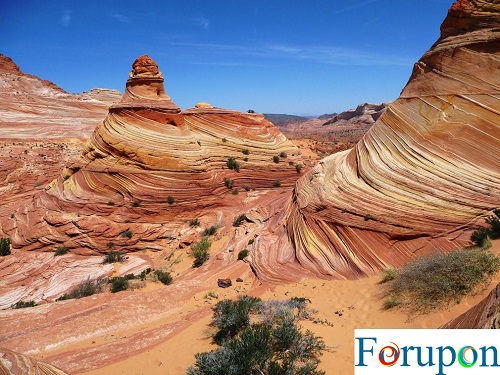Erosion
Erosion on Soil: Erosion is the geological process in which earthen materials are worn away and transported by natural forces such as wind or water.
For upon |Erosion is the geological process in which earthen materials are worn away and transported by natural forces such as wind or water. Erosion whittled these gorgeous spires of Vermillion Cliffs National Monument, Arizona.
Physical Erosion
Physical erosion describes the process of rocks changing their physical properties, such as getting smaller or smoother. Sea stacks, like these in New Brunswick, Canada, are the result of an entire headland being physically eroded away.
Chemical Erosion
1Chemical erosion describes the process of rocks changing their chemical composition as they erode. Chemical erosion contributed to the beautiful Stone Forest in Yunnan, China, for example. Here, rainwater interacts with the limestone rocks in a process called carbonation, resulting in the creation of a weak acid (carbonic acid) that erodes the surface of the rock.
Water Erosion
Liquid water is the most common agent of erosion. Rainwater, rivers, and the ocean continually erode rock, sand, and soil. The pounding waves of the Atlantic Ocean eroded the foundations of this home in the Outer Banks, North Carolina.
Wind Erosion
The wind is a powerful force of erosion. This thick cloud drifting over the Atlantic Ocean is a beautiful example of wind erosion—dust from the Sahara Desert being transported by wind to northern South America.
Erosion Control
Erosion control is the process of reducing erosion by wind and water. For example, communities often invest in windbreaks and riparian buffers to protect valuable agricultural land. Here, California Conservation Corps workers set willows into the steep banks of Taylor Creek, near Lake Tahoe, California. The trees control erosion into the waterway, which is the spawning ground for kokanee salmon and crayfish.
Glacial Erosion
Ice, usually in the form of glaciers or ice sheets, is a large-scale agent of erosion. Here, eroded rubble (called moraine) collects in front of the path of a glacier on the Tronador volcano in Chile.
Grand Canyon
Other factors can contribute to erosion: topography, climate, and vegetation. Even the movement of the Earth itself (tectonic activity) can contribute to the disintegration and transport of sediment. In a span of about 5 million years, tectonic uplift caused the Colorado River to cut deeper and deeper into the Colorado Plateau, creating the gorgeous Grand Canyon, Arizona—more than 1,600 meters (1 mile) deep and as much as 29 kilometers (18 miles) wide. Erosion on Soil.
Dust Bowl
Erosion is a natural process, but human activity can make it happen more quickly. The altering of natural ecosystems for agricultural development is one of the most dramatic forces contributing to erosion. Made brittle by years of drought and agricultural mismanagement, millions of tons of valuable topsoil were eroded away by strong winds in what came to be known as “black blizzards” during the Dust Bowl of the 1930s in North America. Erosion on Soil.
Physical Erosion
Erosion by Water
- Splash erosion describes the impact of a falling raindrop, which can scatter tiny soil particles as far as .6 meters (2 feet).
- Sheet erosion describes erosion caused by runoff.
- Rill erosion describes erosion that takes place as runoff develops into discrete streams (rills).
- Finally, gully erosion is the stage in which soil particles are transported through large channels. Gullies carry water for brief periods of time during rainfall or snowmelt but appear as small valleys or crevasses during dry seasons.
Erosion by Wind
Erosion by Ice
Other Forces of Erosion
Factors Impacting Erosion
Erosion and People

The beach beneath this beach house has eroded away
Photograph by Richard Barnes, National Geographic https://www.nationalgeographic.org/encyclopedia/erosion/
Solar Erosion
The sun itself is actually an instrument of erosion! As rocks heat up, they expand. Expanding rocks can sometimes crack and crumble away.
Far-Flung Dust
The wind is a powerful force. It can carry huge amounts of dust over long distances. In the winter and spring of 2004, winds eroded 45 million tons of dust from a spot called the Bodele Depression in the desert of northern Chad all the way across the Atlantic Ocean to Brazil.
Articles & Profiles
- SF Gate: How to Control Erosion Around a House Foundation
- SoftSchools.com: Physical Weathering Examples
- National Parks Service: What’s the Difference Between Weathering and Erosion?
- Agriculture Victoria: Gully Erosion
- National Park Service: Grand Canyon—Geologic Formations
- LiveScience: Glaciers Erode Land Faster Than Thought
The article was originally published here.


Comments are closed.